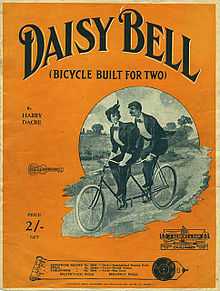Daisy Bell
| "Daisy Bell" | |
|---|---|
 | |
| Song | |
| Released | 1892 |
| Composer | Harry Dacre |
 |
Daisy Bell
Sung by Edward M. Favor. Recorded by the Edison Phonograph Company on brown wax cylinder in 1894
|
| Problems playing this file? See media help. | |
"Daisy Bell (Bicycle Built for Two)" is a popular song, written in 1892 by Harry Dacre, with the well-known chorus "Daisy, Daisy / Give me your answer, do. / I'm half crazy / all for the love of you", ending with the words "a bicycle built for two".
History
"Daisy Bell" was composed by Harry Dacre in 1892. As David Ewen writes in American Popular Songs:[1]
When Dacre, an English popular composer, first came to the United States, he brought with him a bicycle, for which he was charged import duty. His friend William Jerome, another songwriter, remarked lightly: "It's lucky you didn't bring a bicycle built for two, otherwise you'd have to pay double duty." Dacre was so taken with the phrase "bicycle built for two" that he soon used it in a song. That song, Daisy Bell, first became successful in a London music hall, in a performance by Katie Lawrence. Tony Pastor was the first to sing it in the United States. Its success in America began when Jennie Lindsay brought down the house with it at the Atlantic Gardens on the Bowery early in 1892.
The song was originally recorded and released by Dan W. Quinn in 1893, charting at number-one for nine consecutive weeks.[2]
Milestones in technology
In 1961 an IBM 704 became the first computer to sing, in a demonstration of Bell Labs' newly invented speech synthesis – and the song was "Daisy Bell".[3] Vocals were programmed by John Kelly and Carol Lochbaum and the accompaniment was programmed by Max Mathews. In a famous scene in the 1968 science fiction film 2001: A Space Odyssey, the intelligent HAL 9000 computer during its deactivation loses its mind and degenerates to singing "Daisy Bell", which was one of the first things HAL learned when it was originally programmed. The author of the story, Arthur C. Clarke, had seen the 1961 demo.[4]
In 1974 auditory researchers used the melody for the first demonstration of "pure dichotic" (two-ear only) or "pure cyclotean" (one "ear" in the mind that combines the two external ears) perception. They encoded the melody in a stereo signal that could be perceived in the brain only by noticing the phase differences between what each ear heard.[5]
In April 1975 at the Homebrew Computer Club's fourth meeting, in Menlo Park, California, Steve Dompier played "The Fool on the Hill" and "Daisy Bell" using an Altair 8800 and a radio.[6]
Recordings
- Alvin and the Chipmunks covered the song for a 1961 episode of The Alvin Show and their 1962 album The Chipmunk Songbook.
- Blur covered the song as a B-side on their 1993 single "Sunday Sunday".
- Tin Hat recorded a rendition of the song for their 2007 album The Sad Machinery of Spring, with the same lyrics but different music.
References
- ↑ Ewen, David (1966). American Popular Songs. Random House. ISBN 0-394-41705-4.
- ↑ Whitburn, Joel (1986). Pop Memories 1890–1954. Record Research. ISBN 0-89820-083-0.
- ↑ National Recording Registry Adds 25 – The Library Today (Library of Congress)
- ↑ Background: Bell Labs Text-to-Speech Synthesis
- ↑ Kubovy, M.; Cutting, J. E.; McGuire, R. M. . (1974). "Hearing with the Third Ear: Dichotic Perception of a Melody without Monaural Familiarity Cues". Science 186 (4160): 272–274. doi:10.1126/science.186.4160.272. PMID 4413641.
- ↑ Ichbiah, Daniel; Knepper, Susan (1991). The Making of Microsoft: How Bill Gates and His Team Created the World's Most Successful Software Company. Prima Lifestyles. ISBN 1-55958-225-1. ; cited in Polsson, Ken. "Chronology of Personal Computers". Retrieved 2008-09-30.
External links
| Wikisource has original text related to this article: |
- Lyrics with .midi on National Institutes of Environmental Health services website
- "Daisy Bell. Song.". Levy Sheet Music Collection, Box 140, Item 090. Johns Hopkins University. March 30, 2007.
- The Daisy Bell Page (compiled by Chris Komuves)
- Works of Edward M. Favor, including an 1894 recording of "Daisy Bell" (MP3)
- Page featuring a recording of "Daisy Bell" sung and played by IBM computers at Bell Laboratories in the early 1960s
- The free score on www.traditional-songs.com